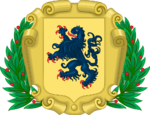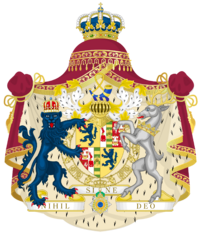House of Ahnern: Difference between revisions
No edit summary |
No edit summary |
||
| Line 37: | Line 37: | ||
The Ahnern family was formerly known as the Lünburg family which ruled as two separate branches, the Aldian and Fanian line, in the respective [[Aldia|Duchy of Aldia]] and [[Aldia|Grand Duchy of Fania]] since the 13th century. Both had a distinct development, with the members of the Aldian line becoming Margraves of Bolchar and members of the Fanian line ruling the principalities of Fania-Tormundshaff and Fania-Beisach. The {{wp|intermarriage}} of both houses birthed the united House of Lünburg and the formation of a {{wp|personal union}} as [[Aldia|Aldia-Fania]] under Fanian Grand Duke Joseph I in 1297. After the gradual decline and [[partitions of Cuthland]] in the 18th century, Aldia was recognized as one of [[Berea]]'s great powers, was elevated to the [[Kingdom of Aldia]] in 1647, and effectively pushed for an effort of Mascyllary unification which eventually succeeded through the unification of [[Mascylla]] after the [[War of the Five Kings]] in 1793. | The Ahnern family was formerly known as the Lünburg family which ruled as two separate branches, the Aldian and Fanian line, in the respective [[Aldia|Duchy of Aldia]] and [[Aldia|Grand Duchy of Fania]] since the 13th century. Both had a distinct development, with the members of the Aldian line becoming Margraves of Bolchar and members of the Fanian line ruling the principalities of Fania-Tormundshaff and Fania-Beisach. The {{wp|intermarriage}} of both houses birthed the united House of Lünburg and the formation of a {{wp|personal union}} as [[Aldia|Aldia-Fania]] under Fanian Grand Duke Joseph I in 1297. After the gradual decline and [[partitions of Cuthland]] in the 18th century, Aldia was recognized as one of [[Berea]]'s great powers, was elevated to the [[Kingdom of Aldia]] in 1647, and effectively pushed for an effort of Mascyllary unification which eventually succeeded through the unification of [[Mascylla]] after the [[War of the Five Kings]] in 1793. | ||
The King of Aldia [[Monarchy of Mascylla#List|Lucas II]] subsequently ascended to the status of [[Monarchy of Mascylla|Mascyllary King]]. In the 19th century, it influenced multiple Berean monarchies through marriage and political alliances, namely the [[Monarchy of Lavaria|Lavish]], [[Monarchy of Norden|Nordic]], [[Emperor of Dulebia|Dulebian]] and [[List of monarchs of Valimia|Valimian]] monarchies. In 1923 however, the [[Mascyllary Revolution]] led to the initial expelling of the monarchy, but it was later re-instituted as [[Monarchy of Mascylla|a constitutional monarchy]] which continues to the present in Mascylla. Current nominal head of the Ahnern family is [[Dorothea I]], Queen of Mascylla since 2005, although the disputed {{wp|order of succession}} after the [[Mascyllary Revolution of 1847]] and the establishment of the House of Ahnern-Welsbach under [[Monarchy of Mascylla#List|Sophia I]] led to multiple {{wp|pretender|pretenders}} claiming to be the actual historic {{wp|heir|heirs}} and family heads. | The King of Aldia [[Monarchy of Mascylla#List|Lucas II]] subsequently ascended to the status of [[Monarchy of Mascylla|Mascyllary King]], renamed the House of Lünburg to the House of Ahnern and moved the family seat to Hohenehr Palace outside [[Königsreh]]. In the 19th century, it influenced multiple Berean monarchies through marriage and political alliances, namely the [[Monarchy of Lavaria|Lavish]], [[Monarchy of Norden|Nordic]], [[Emperor of Dulebia|Dulebian]] and [[List of monarchs of Valimia|Valimian]] monarchies. In 1923 however, the [[Mascyllary Revolution]] led to the initial expelling of the monarchy, but it was later re-instituted as [[Monarchy of Mascylla|a constitutional monarchy]] which continues to the present in Mascylla. Current nominal head of the Ahnern family is [[Dorothea I]], Queen of Mascylla since 2005, although the disputed {{wp|order of succession}} after the [[Mascyllary Revolution of 1847]] and the establishment of the House of Ahnern-Welsbach under [[Monarchy of Mascylla#List|Sophia I]] led to multiple {{wp|pretender|pretenders}} claiming to be the actual historic {{wp|heir|heirs}} and family heads. | ||
[[Category:Mascylla]] {{Template:Mascyllatopics}} | [[Category:Mascylla]] {{Template:Mascyllatopics}} | ||
Revision as of 09:53, 24 September 2021
This article is incomplete because it is pending further input from participants, or it is a work-in-progress by one author. Please comment on this article's talk page to share your input, comments and questions. Note: To contribute to this article, you may need to seek help from the author(s) of this page. |
| House of Ahnern Haus Ahnern | |
|---|---|
| Royal dynasty | |
 Coat of arms of the Counts of Ahnern | |
| Country | Mascylla, Dulebia |
| Founded | 1459 |
| Founder | Ludwig, Count of Ahnern |
| Current head | Dorothea I of Mascylla |
| Titles | List
|
| Estate(s) | Mascylla, Adwhin, Dulebia |
| Deposition | Dulebia, 1914: monarchy abolished during the Dulebian Civil War |
| Cadet branches | Mascylla
Dulebia |
The House of Ahnern (Hesurian: Haus Ahnern, [ˈʔaːnərn]) is a Telmerian royal house and dynasty of Mascyllary origin and currently reigning as Kings of Mascylla. As a rather influential royal house they have integrated into other countries' monarchies, such as Lavaria, Norden and Dulebia, the latter of which having been ruled by the cadet branch of the House of Ahnern-Loxstedt-Hoeveden-Zhdanovy formally jointly with the House of Loxstedt-Hoeveden through Mary Zhdanova and Alexander III; it was deposed however during the Dulebian Civil War. Since the War of the Five Kings and the foundation of Mascylla, the House of Ahnern has been its continuous ruling dynasty, producing eight Mascyllary monarchs, a Dulebian empress and emperor, and dozens of other members of nobility such as counts, princes, dukes and grand dukes.
The Ahnern family was formerly known as the Lünburg family which ruled as two separate branches, the Aldian and Fanian line, in the respective Duchy of Aldia and Grand Duchy of Fania since the 13th century. Both had a distinct development, with the members of the Aldian line becoming Margraves of Bolchar and members of the Fanian line ruling the principalities of Fania-Tormundshaff and Fania-Beisach. The intermarriage of both houses birthed the united House of Lünburg and the formation of a personal union as Aldia-Fania under Fanian Grand Duke Joseph I in 1297. After the gradual decline and partitions of Cuthland in the 18th century, Aldia was recognized as one of Berea's great powers, was elevated to the Kingdom of Aldia in 1647, and effectively pushed for an effort of Mascyllary unification which eventually succeeded through the unification of Mascylla after the War of the Five Kings in 1793.
The King of Aldia Lucas II subsequently ascended to the status of Mascyllary King, renamed the House of Lünburg to the House of Ahnern and moved the family seat to Hohenehr Palace outside Königsreh. In the 19th century, it influenced multiple Berean monarchies through marriage and political alliances, namely the Lavish, Nordic, Dulebian and Valimian monarchies. In 1923 however, the Mascyllary Revolution led to the initial expelling of the monarchy, but it was later re-instituted as a constitutional monarchy which continues to the present in Mascylla. Current nominal head of the Ahnern family is Dorothea I, Queen of Mascylla since 2005, although the disputed order of succession after the Mascyllary Revolution of 1847 and the establishment of the House of Ahnern-Welsbach under Sophia I led to multiple pretenders claiming to be the actual historic heirs and family heads.
